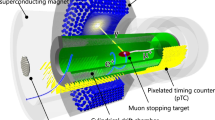Summary
In K 02 →π++π−+γ, the decay can go either through a direct process or through an inner bremsstrahlung process. By applying the method of current algebras we estimate the branching ratio of the directCP-conserving process with the decay K2→2γ. The result isR 1(K 02 →π+π−γ)/R(K 02 →2γ)≃14%. The inner bremsstrahlung term accompanying theCP-violation process K 02 →π+π− is also calculated. We obtain for the latter the results
whereE γ is the energy of the photon emitted in the process K 02 →π+π−+γ. Using the recent experimental data on the decay rates of K 02 →2γ and K 02 →π+π−, we obtain the total rateR(K 02 →π+π−γ)≃(2.1±0.4)·103s−1, forE γ≥10 MeV.
Riassunto
Nel processo K 02 →π++π−+γ, il decadimento può avvenire o direttamente oppure attraverso un processo di bremsstrahlung interno. Applicando il metodo dell’algebra delle correnti, si calcola il rapporto fra gli eventi che conservanoCP e il decadimento K2→2γ. Il risultato èR 1(K 02 →π+π−γ)/R(K 02 )≃14%.. Si calcola inoltre il termine di bremsstrahlung interno connesso coll’evento K 02 →π++π−, che violaCP. Per quest’ultimo si ottengono i seguenti risultati:
doveE γ è l’energia del fotone emesso nel processo K 02 →π++π−+γ. Utilizzando gli ultimi risultati sperimentali sui valori di decadimento di K 02 →2γ e K 02 →π++π−, si ottiene il valore totaleR(K 02 →π+π−γ)≃(2.1±0.4)·103s−1,, perE γ≥10 MeV.
Резюме
В B K 02 →π++π−+γ, распад может идти либо через прямой процесс или через процесс внутреннего тормозного излучения. Применяя метод алгебр токов, мы оцениваем отношение ветвей для прямого, сохраняющегоCP процесса с распадом K2→2γ. Результат следующийR 1(K 02 →π+π−γ)/R(K 02 →2γ)≃14%. Также вычисляется член внутреннего тормозного излучения, сопровождающих процесс с нарушениемCP. Для последнего случая мы получаем следующие результаты
гдеE γ энергия фотона, испущенного в процессе K 02 →π++π−+γ. Используя недавние экспериментальные данные по скоростям распадов K 02 →2γ и K 02 →π+π−, мы получаем полныю скоростьR(K 02 →π+π−γ)≃(2.1±0.4)·103 сек−1 дляE γ≥10 МэВ.
Similar content being viewed by others
References
K. Kawarabayashi andM. Suzuki:Phys. Rev. Lett.,16, 255 (1966).
M. Ademollo andR. Gatto:Nuovo Cimento,44 A, 282 (1966);J. Pasupathy andR. E. Marshak:Phys. Rev. Lett.,17, 888 (1966).
H. R. Rubinstein andG. Veneziano:Phys. Rev. Lett.,18, 411 (1967).
J. W. Cronin, P. F. Kunz, W. S. Risk andP. C. Wheeler:Phys. Rev. Lett.,18, 25 (1967).
J. M. Gaillard, F. Krienen, W. Galbraith, A. Hussri, M. R. Jane, N. H. Lipman, G. Manning, T. Ratcliffe, P. Day, A. G. Parham, B. T. Payne, A. C. Sherwood, H. Faissner andH. Reithler:Phys. Rev. Lett.,18, 20 (1967).
J. K. Knipp andG. E. Uhlenbeck:Physica,3, 425 (1936);F. Block:Phys. Rev.,50, 272 (1936).
M. Gell-Mann:Phys. Rev. Lett.,12, 155 (1964);Y. Hara andY. Nambu:Phys. Rev. Lett.,16, 875 (1966).
M. K. Gaillard:Phys. Lett.,20, 533 (1966);C. G. Callan andS. B. Treiman:Phys. Rev. Lett.,16, 153 (1966);R. Gatto, M. Maiani andG. Preparata:Nuovo Cimento,41, 622 (1966).
S. Weinberg:Phys. Rev. Lett.,17, 336 (1966).
J. D. Good:Phys. Rev.,113, 352 (1959).
A. H. Rosenfeld, A. Barbaro-Galtieri, W. J. Podolsky, L. R. Price, P. Soding, C. G. Wohl, M. Roos andW. J. Willis:Rev. Mod. Phys.,39, 1 (1967).
S. Oneda, Y. Kim andD. Korff:Phys. Rev.,136, B 1064 (1964).
Author information
Authors and Affiliations
Additional information
Work supported in part by the National Science Foundation and by the U.S. Army Research Office, Durham.
Traduzione a cura della Redazione.
Перевебено ребакцией.
Rights and permissions
About this article
Cite this article
Lai, C.S., Young, B.L. Calculation of the decay rate of K 02 →π++π−+γ. Nuovo Cimento A (1965-1970) 52, 83–90 (1967). https://doi.org/10.1007/BF02739275
Received:
Published:
Issue Date:
DOI: https://doi.org/10.1007/BF02739275




